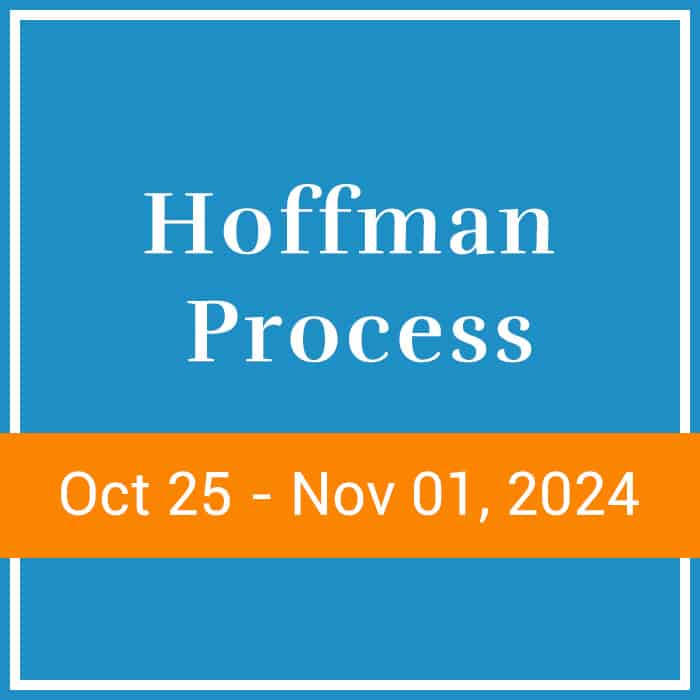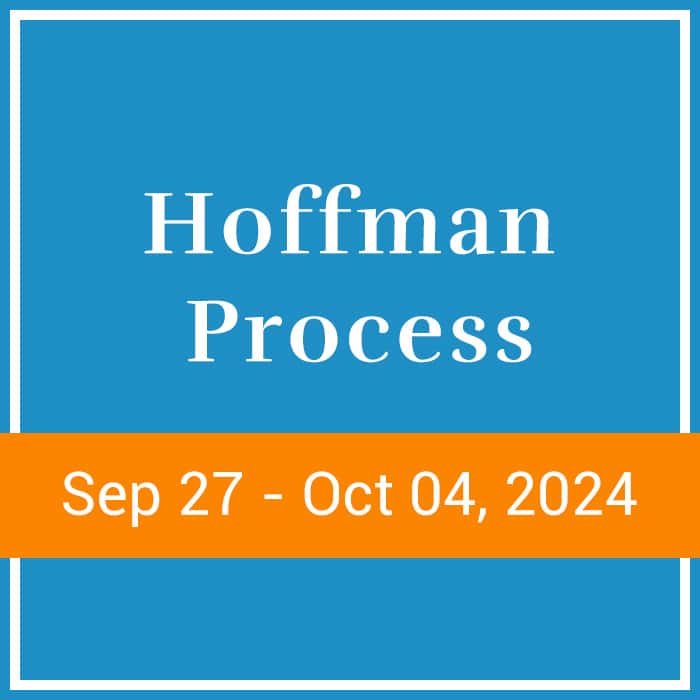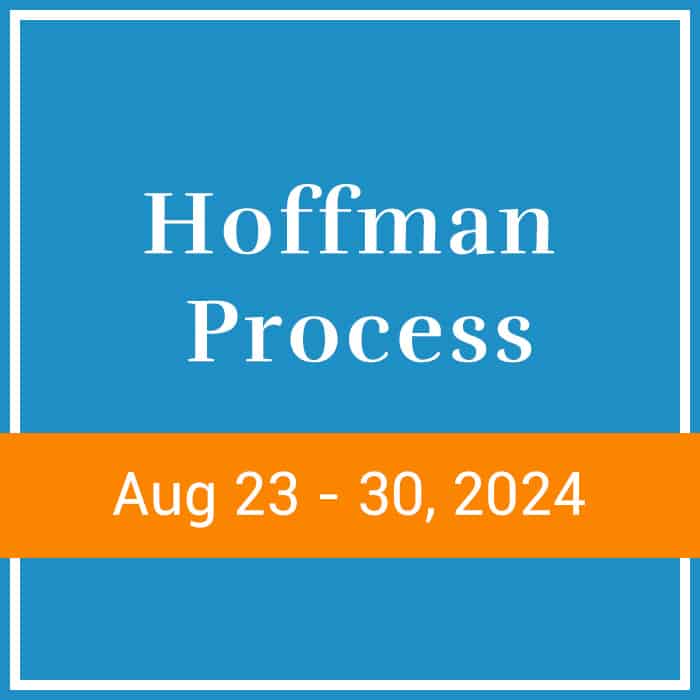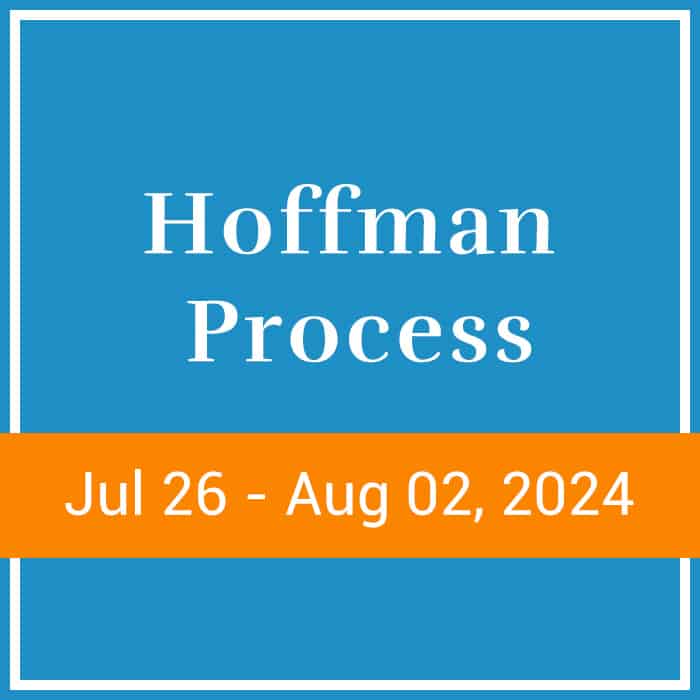Annie: I’m here with a wonderful facilitator Julia Bodkin who is a very experienced somatic psychotherapist and also a senior Hoffman facilitator. I am excited to be speaking with Julia today about trauma and how the Hoffman process addresses trauma and helps to build resiliency.
Julia, you’ve been working with trauma now for many years one-on-one – I know that it’s a big topic but wondered if you can talk about how the Hoffman process, being a group process, helps people in dealing with and healing trauma.
Julia: Yes, I’m happy to do that because over the years I’ve seen that the process is much more helpful in dealing with trauma than I realized when I first started facilitating. There are different kinds of trauma but generally, the way to work with trauma and PTSD (post-traumatic stress disorder) symptoms, is in a private one-on-one session. This is probably still the most effective for a very shocking or severe single incident trauma, but many symptoms that come under the umbrella of trauma are greatly alleviated by the Hoffman process.
Annie: So what are the different types of trauma that we’re talking about?
Julia: Well, single incident trauma is when one traumatic event occurs, like a road accident or a physical or emotional injury of some sort. It’s a one-off overwhelming experience for the person and can lead to intense adverse symptoms. And then there is developmental trauma that has more to do with the way that we were parented, how attachment was set up and how we were treated as children – it is laid down over many years and is more pervasive and can be harder to define.
What defines trauma is not the event itself, it’s the way the person responds to the event that determines whether the trauma has an on-going negative impact on the person.
Simply put, the definition of trauma is overwhelm; too much, too fast, too soon – it is when our nervous system is overwhelmed in some way and is unable to process the event or events. So this is also the case in developmental trauma or an early childhood trauma. It may be that for a period of a person’s childhood there was some kind of emotional abuse or physical abuse, extreme criticism or neglect and if this is an ongoing experience for the child then the nervous system is in a state of distress. A seemingly small event on its own wouldn’t have so much impact but if it’s a pervasive atmosphere or the situation is repeated enough times it culminates into a burden on the nervous system of the child that can lead to all kinds of adaptive reactions and behaviors. These behaviors become patterns that may have even been useful in childhood, as a means of survival, but they become maladaptive as we grow up. An example of this would be avoiding any perceived conflict.
Annie: So that sounds like it relates to what Bob Hoffman called the Negative love syndrome. Do you see a cross over with that model and trauma?
Julia: Yes. When we live from a belief that we took on from our early childhood experiences – that’s what creates the Negative Love Syndrome. One of the things that we get to see so clearly in the process is that we made meaning out of negative experiences in our childhood. Our perceptions of the ways that we were treated or difficult circumstances lead us to take on negative beliefs about ourselves – “I’m unworthy”, “I don’t belong”, “the world is unsafe”, for example are in a way states of trauma and lenses that we then see through and live our lives from.
A lot of the first part of the process is about becoming aware of these beliefs, seeing how they live in our minds and bodies and as the week progresses, through a series of very well structured exercises, moving us towards a sense of wholeness and health.
To use a term that Bessel van der Kolk uses the healing of trauma is about ‘dis-confirming the traumatizing reality’ which is what we do in the Hoffman process as we start to challenge the false beliefs that our negative patterns hold us to… and we start to open up to and experience the actual reality that we are loved, that we are loving, and that we are lovable.
An important part of the week is that we have processes that lead us into the embodiment of this truth because the healing has to happen in the body because that’s a large part of where the trauma has become stuck. It is cumulative and is held in the body.

Book a Free Consultation
Would you like to find out more about the Process?
Book a free 1 hour consultation with one of our facilitators
Annie: So, trauma is held in the body, it’s not just a mental health issue.
Julia: That’s right, and this is a very important point to recognize. It’s been well researched that the only effective resolution of trauma is when it’s addressed somatically, through the body, not only by talking about it. It’s been well documented that talking about the traumatic event or replaying negative childhood experiences without addressing it through movement and other ways of releasing where it is held in the body can actually be re-traumatising.
Trauma becomes stuck in the body when the difficult situation (trauma) occurs, and the person’s fight or flight response has not been able to happen. It’s when an event or events have been overwhelming in some way but the person hasn’t been able, for whatever reason, to protect themselves nor have they been able to run away. The natural reflex of fight or flight was thwarted causing the person to freeze, and then the energy and adrenaline that was produced and would have been released is held in the body. It’s as if the switch that indicates danger is stuck ON and then becomes a kind of looping in the mind that leads to beliefs like ‘I’m not safe’, ‘It’s dangerous to speak up’, ‘I should always be on guard’. Once the trauma is released these beliefs are seen to be false and a natural sense of strength and ability to protect ourselves returns.
Annie: So, given trauma is held in the body, then what are some of the kinds of things that the Hoffman process works through that can move the trauma out of the body?
Julia: Well, many things, but probably the most obvious is the physically cathartic work that we do in relation to the negative patterns adopted from our parents. In a very safe and supported environment there is space and time given to expression – as someone connects to their feelings, they are then able to give an energized, emotionally charged voice to the part of them that had not spoken up before.
So someone who as a child had, for example, had a consistently overbearing father, a very controlling mother or a situation that was scary or disempowering on a continuous basis is often in a kind of traumatized state – this can shift when the part of them that was shut down is allowed to speak up. The energy that was repressed and ‘socialized’ can be expressed and move out of the body through the completing of a ‘fight response’ against whatever the negative energy was that was coming towards them. So in the case of an aggressive care giver and especially in the case where there was any sort of physical violence or lack of safety in some way this is a place where repair can happen on a cellular level because the person gets to feel the capacity that they have now that they didn’t have then and now they can defend themselves. They’re able to complete what they weren’t able to do then. This is incredibly empowering and wonderful, for example, for people who have difficulty setting boundaries.
There’s not often a need in adult life to speak up from a place of aggression but we want to have access to that part so that if there is an aggressor, we are able to respond appropriately and not be hijacked by a trauma response and freeze. And there is definitely a need to set boundaries.
Annie: And this part of the process can be quite intense – is there any risk when people have had trauma that they can be re-traumatized through that part of the process?
Julia: That could only happen if the person isn’t grounded and prepared. But there is a lot of preparation before this part. We are aware of each person’s history so we know how to help them to have enough resources and to build the resiliency that they need to go into the expression.
Annie: So when you refer to resources or resiliency, can you say more about that?
Julia: Yeah. Resiliency could be defined as ‘the capacity to prepare for, recover from and adapt in the face of stress, adversity, or challenge’. It makes all the difference because trauma is cumulative so if it’s not dealt with then it builds up – resiliency gives us the capacity to process trauma. And how much we are affected by a traumatic event directly correlates to how resilient and resourced we are. Hoffman builds resiliency in multiple ways.
One seemingly simple thing is that at Hoffman you learn to build the capacity to process emotions and be with feelings more and more. You learn how to be closer to yourself rather than push parts of yourself away. One of the reasons that this is important is because we get re-traumatized if we’re in dissociation, if we’re disconnected and just going through the motions. But if you keep building on the capacity to be able to tolerate feelings, be in your body, be with your emotions, and it’s not overwhelming, you start to be able to deal with one piece at a time, which is what allows the processing and releasing of trauma. It’s so helpful to be able to deal with bite-size pieces of feelings at a time allowing them to transform into strength and resiliency as opposed to shut down and collapse.
Annie: So it’s a very safe space and participants are resourced with various techniques to keep them grounded and present, so they’re able to deal with the trauma in manageable chunks. How do you build resiliency throughout the process?
Julia: There are too many to mention here but the major one is that a large part of the Hoffmann process is about grounding oneself in what can be called our ‘true self’, our ‘essential being’, our ‘spiritual self’. And there are multiple practices that we work with on the process that build resiliency on a spiritual level. As this experience of our spiritual self deepens, we start to realize that we are not our trauma that we are not the negative patterns – that we are magnificent beings. We have exercises where time is spent experiencing the actual felt sense of embodied qualities of our true self. And from that place, then we’re more able to deal with one piece at a time of whatever we encounter in life. That’s true resiliency.
Annie: You’ve mentioned safety quite a bit. I understand that creating a safe space or having a safe place, as a child, or as anyone that’s been in a traumatic situation is incredibly important. How does Hoffmann create this sort of safe place? Are there other things throughout the process that resource the person into a sense of safety?
Julia: Yes, the way that the group is facilitated is very much with emotional safety in mind, the group itself becomes a safe place to be. But more than anything, we invite and support people to create that safety within themselves. The Hoffmann process is ultimately a re-parenting of oneself and there are many different processes that build on that. Your inner environment becomes a safer place to be and with that comes the inner capacity and strength to deal with challenges as they arise.
Annie: You mentioned earlier PTSD, and intense symptoms that have arisen out of a single incident trauma; in what way have you seen that the process addresses these issues?
Julia: I have seen some amazing shifts for people who have come to the process with some pretty debilitating symptoms. It can often be that someone had a trauma way back in their childhood or teens that wasn’t addressed and because they didn’t experience any symptoms, there didn’t seem to be the need. Later on they have a very difficult situation, say bullying at work that they struggle with but manage to move on from and then in their 30’s they have a relationship break up, for example, and it’s like the straw and the camel – suddenly they start to experience trauma symptoms like panic attacks, chronic anxiety, a breakdown of some sort, obsessive behavior, substance abuse or other addictions take hold. It seems as if these symptoms are from the break up but it’s actually an accumulation and a lack of resources and a wearing down of resiliency that has just tipped them over.
I have seen people come to the process with various versions of this scenario and have had their lives turned around from coming to Hoffman. The healing of trauma is moving from fragmentation to wholeness and this is so much of what I see happening for people on the process. Of course, each individual case is taken into consideration and there have been times when a one on one session or two before or after the process has been needed for extra support but the transformations that I’ve seen have been a delight to witness.
Annie: Yes! And lastly, I realize that there’s so much more to learn on this topic so can you recommend some reading material for those who would like to read more about how to understand and deal with trauma?
Julia: There are some great books and also some good clips on you tube explaining different aspects of trauma. Some of my favorites are Bessel Van der Kolk – The body keeps the score, Peter Levine – Waking the Tiger and In an unspoken Voice, Babette Rothschild – The Body Remembers. And there is more information about two of the most effective treatments of trauma, Somatic Experiencing and EMDR, on my website at www.byronbaytherapy.com

Free Download
Book a free 1 hour consultation with one of our facilitators
Booklet Download
[ipt_fsqm_form id=”25″]
Thank You!
Excellent! You can now download ebook PDF
Download
What’s Next?
There a few things you can do to find out if the Process is for you:
• Take our “Is the Process for me?” self-assessment test to learn if the Process if right for you
• Read our Frequently Asked Questions for more information
• Read what our Graduates have to say about their experience before and after doing the Process
• Take advantage of this great offer and book a free 1 hour consultation with one of our professional therapists
Related Articles on our website
Advocate for men’s mental health, GQ Editor Dylan Jones raises awareness on men’s plight with mental health issues in his candid account of his personal experience of the Hoffman Process
Katy Perry talks to Vogue Magazine about her Hoffman Process experience
Dr Joan Borysenko discusses the Benefits of the Hoffman Process, the limbic brain system connection and the scientific study by the University of California
Dr. J.W. Wilson, Executive Director of the Advanced Learning Institute, Canada discusses how the Hoffman Process creates positive long-lasting changes in brain structure










